Projects involve an array of actions or tasks that have to be completed to achieve the project’s overall objective. Therefore, different people or teams have to be involved, whereby each individual or team is assigned to perform a specific task among different projects. A work breakdown structure template outlines these tasks and the assigned parties for easier management. This way, each party or team can focus on their assigned duties to prevent the intermingling of responsibilities, skipping essential tasks, or reassigning tasks that have already been assigned.
A work breakdown structure or WBS template is also used for evaluation purposes. Since it is often based on the project’s deliverables, project managers can use it to assess each deliverable’s task status or success. It is a tool that highlights all that needs to be done to achieve specific project goals (deliverables). To further clarify the utilization of a WBS, this article will discuss how it is used and the essential components of the document.
Work Breakdown Structure
A work breakdown structure is a visual project management tool used to subdivide the project scope and deliverables into smaller, measurable, and manageable actions or tasks.
It presents these tasks in a hierarchical order starting from a deliverable or milestone. This way, the WBS adopts a tree-like structure.
The overall project’s goal/objective is located at the tip of the tree structure and further broken down into subsequent deliverables and tasks, sub-tasks, work packages, or end terminals. It is important to note that a work breakdown structure should focus on the deliverables of tasks, not the actual actions.
Work Breakdown Structure Template
A work breakdown structure template is a fillable project management tool that outlines the tasks to be completed under each project deliverable.
It ensures the project scope is broken down into more minor actions or activities whose outcomes can be measured. The templates are reusable and can thus be used for different projects. The templates can be used to manage the costs of the entire project, create a project schedule and manage the schedule.
Our readers can obtain such templates when creating the structures for their projects from this site. The templates are free to download. Since they are designed to outline the essential components of a WBS, they are a faster approach to creating the structures. All a user is required to supply the appropriate information in the blank options. They are also customizable, and users can therefore add or remove sections in the WBS template.
Free Templates for Word
Given below are work breakdown structure templates:
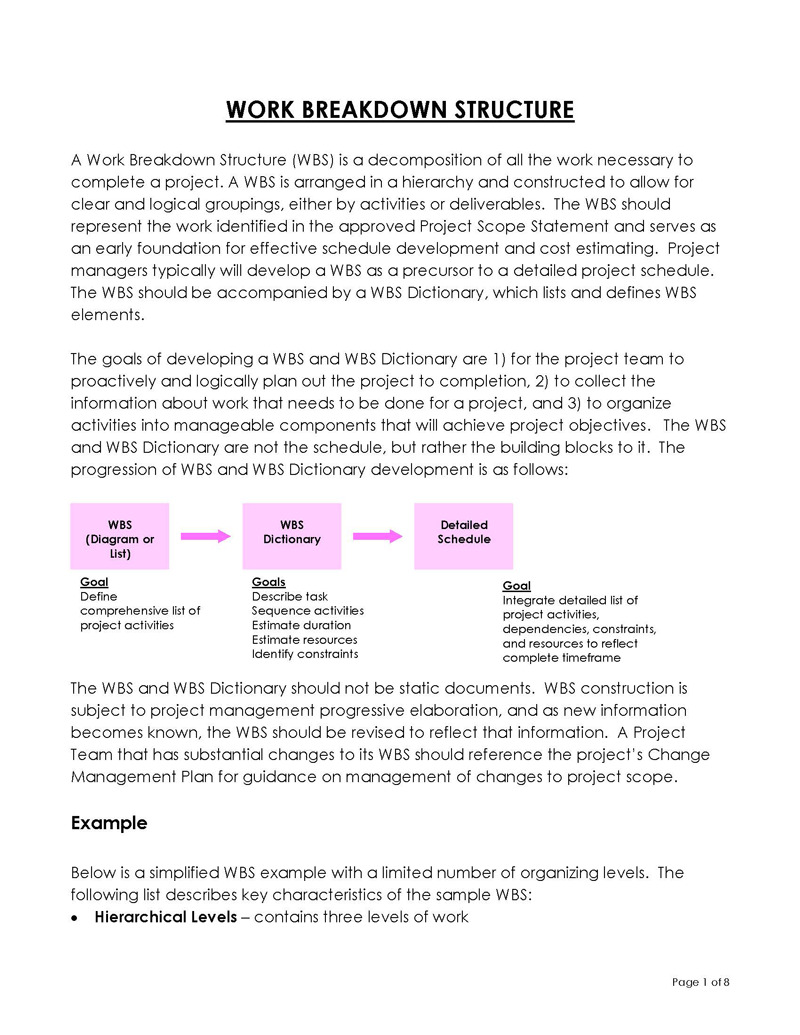


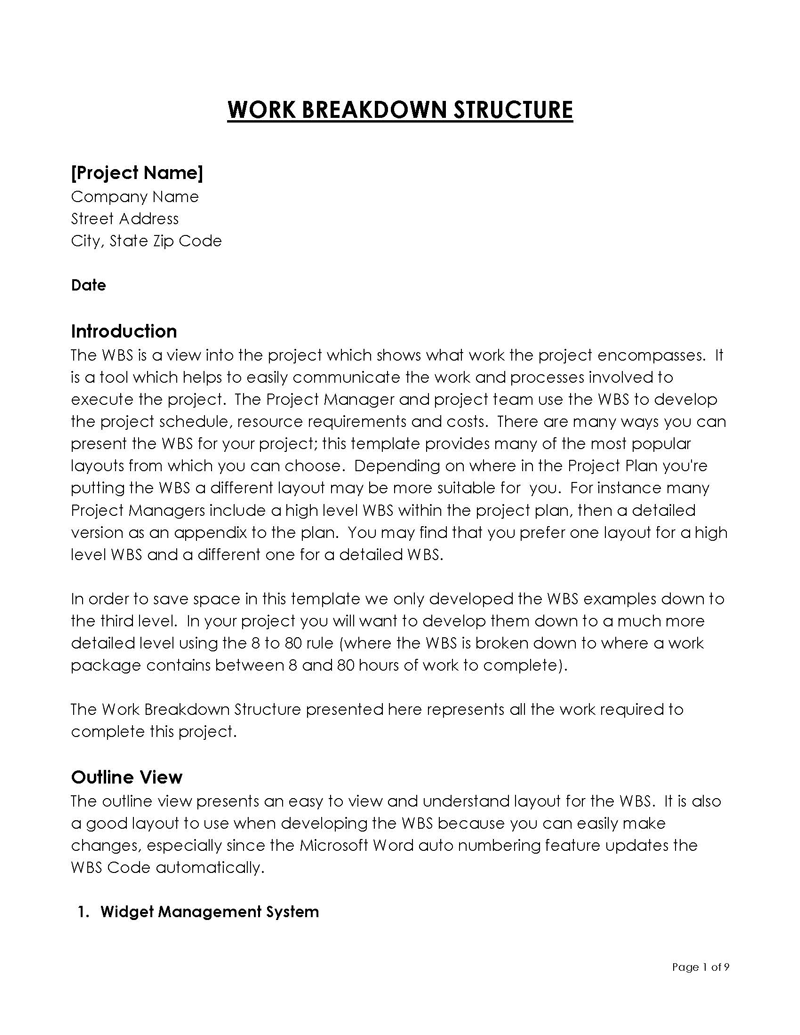
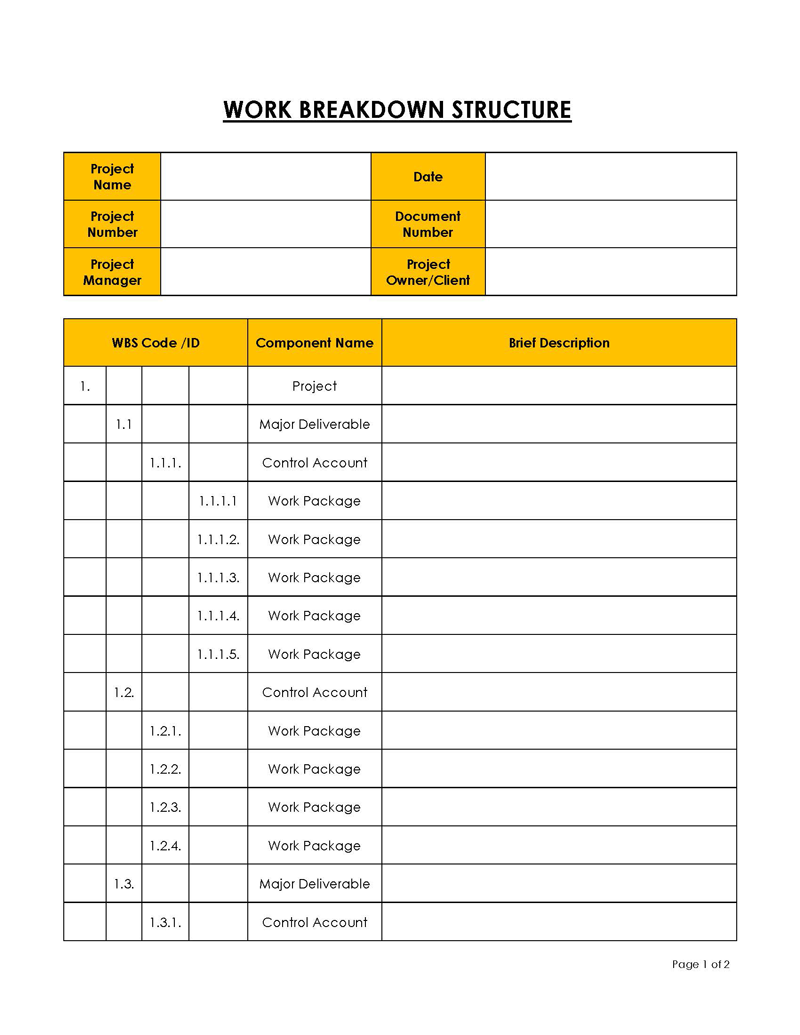
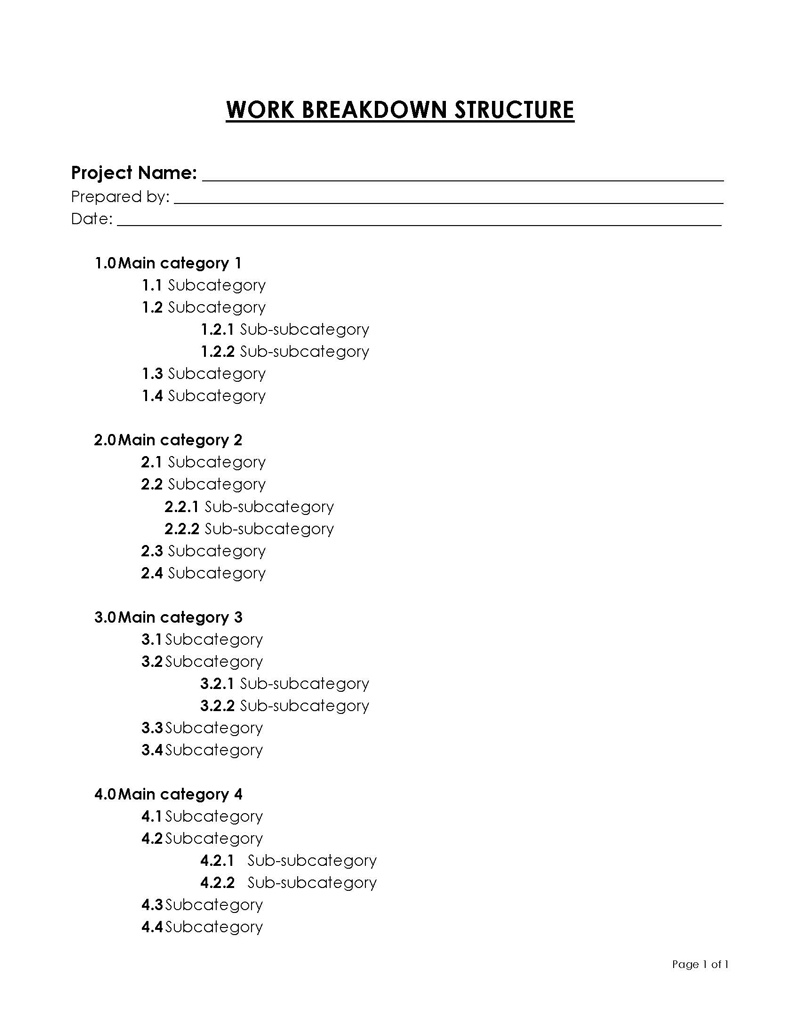
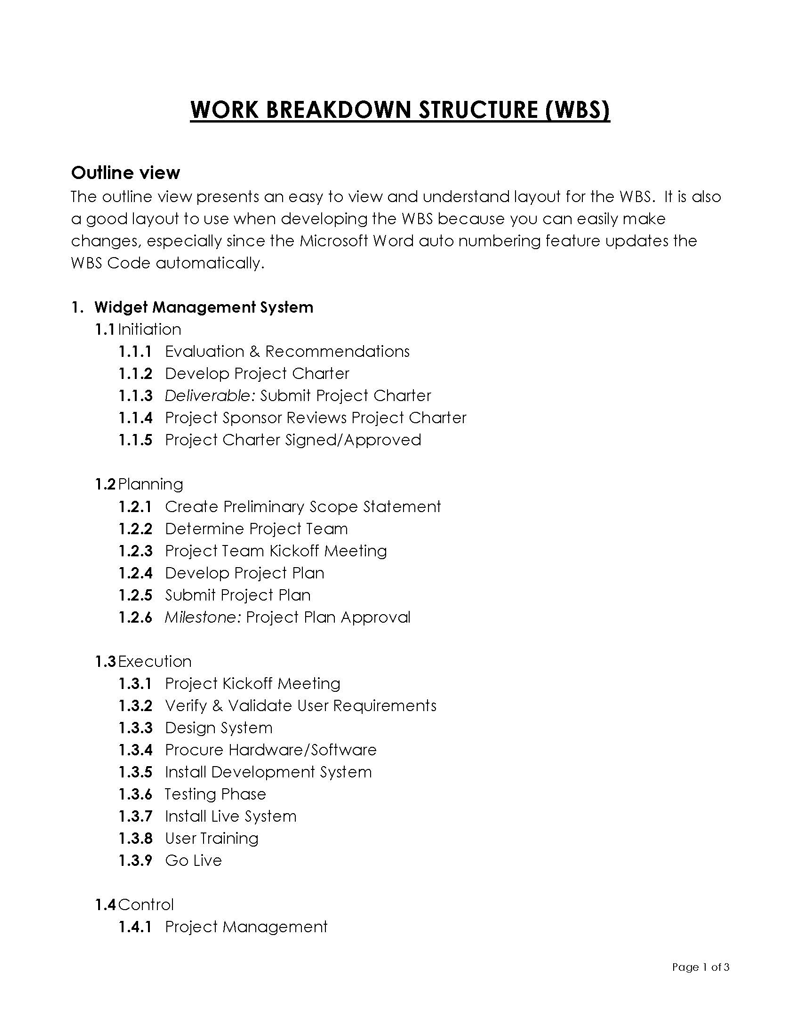
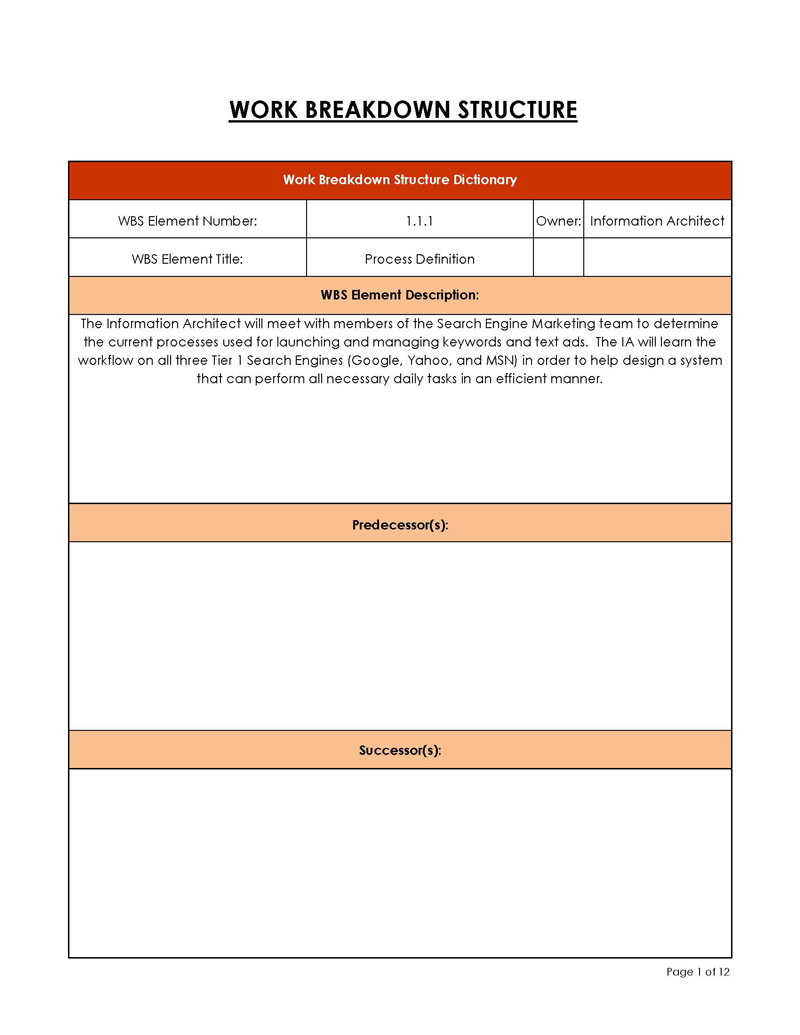
Uses of Work Breakdown Structure Template
A WBS template has extensive uses in project management. It is, however, not limited to projects; it can be used in programs and other initiatives where work has to be distributed among different people or teams.
Below is a discussion of who, when, and why a work breakdown structure template is used:
Who
WBS templates are commonly used and created by project managers during the planning stage. This is because they are ordinarily in charge of assigning duties to employees. However, the WBS is executed by the team members involved in the project. Therefore, it is highly advisable to involve the team members when creating the WBS. For example, team leaders can be tasked to prepare a sub-WBS detailing tasks under their department.
The sub-WBSs can then be compiled into a single WBS for the entire project. The project manager can also seek expertise and guidance from project managers and team leaders, reviewing previous information of other similar projects and reading literature about requirements of such types of projects to create a strong WBS.
When
As mentioned above, the work breakdown structure is created at the project’s planning stage. However, the document is used throughout the project cycle until the project’s objectives are accomplished. It is also used when evaluating the success of each team and when evaluating the success of each deliverable.
Therefore, project managers should use a work breakdown structure template when they want to divide the project scope and deliverables into smaller, manageable tasks. This simplifies management, especially for projects with broad scopes and multiple deliverables.
Why
The WBS is used to create a project schedule at the planning phase. This is because the different tasks involved under each deliverable can be defined, and the task duration can be determined. This information is used to create the project’s schedule. By outlining all tasks under a deliverable or milestone, monitoring, and controlling resources and performance becomes simpler.
It is used as a communication tool in project management. It conveys what each individual or team is expected to do and achieve. Presenting this information in a visual representation such as a WBS template simplifies the stakeholder’s expectations into doable actions. This way, ambiguities in the project scope are reduced since responsibilities are adequately clarified in the WBS.
The document also improves accountability within the team because the dependencies between tasks can be established. Delays can also be quickly identified, thus motivating each employee or team to complete their assigned responsibilities.
A work breakdown structure is also used to estimate the overall costs of a project, track project progress and identify associated risks. These are important considerations for proper project management and greatly influence the success of the project.
Components of Work Breakdown Structure Template
It details all that should be done in a project to be termed as successful. An exceptional work breakdown structure template should provide a visual overview of the project scope such that anyone involved in the project can interpret its contents.
The following items should be included in a template with that in mind:
Goals and objectives
The project’s goals and objectives must appear in the WBS. The goals and objectives lay the foundation of what the team wants to achieve by undertaking their assigned responsibilities. This information will often be provided in the project scope. Objectives will vary from one project to another – for example, building a bridge or developing a campaign ad.
Deliverables
The project deliverables at different significant stages of the project should be outlined in the document. In addition, deliverables can be defined as sub-projects within the project. A simple way of identifying project deliverables is determining what each independent team or department will be required to complete in the project. Note that the WBS should be focusing on measurable deliverables and not actions/tasks.
Break deliverables into individual tasks
The template should give a breakdown of the deliverables identified. Each team or individual will often be undertaking more than one task. Each task’s outcome must be measurable either by time or cost.
Task number
Task numbers should be provided for each task. This number is used to determine the tasks performed at each stage. Since deliverables ought to be numbered, often based on an incremental order from the onset to end of the project, tasks under each deliverable will have the deliverable’s number and then be further differentiated as the tasks are divided into subtasks.
Task description
Each task listed in the WBS template should be clearly defined. For example, a task description can mention the specifications, timeline, etc. The definition can be one or two summarizing sentences.
Task owner
The team or team member assigned each task and subtasks must be identified in the WBS. If an individual handles the task or subtask, their name should be supplied in the work structured template. However, if the tasks or subtasks will require a team’s joint effort, the team’s name should be indicated and not the names of all the team members.
Dependency
A work breakdown structure should show the dependencies between tasks. This means some tasks require other tasks to be completed before they can begin therefore creating a dependency. The dependencies can be noted or illustrated using arrows showing the direction of dependency.
Resources needed
The WBS should indicate the resources needed for each task. Resources are primarily all the requirements needed for the task or subtask to be completed successfully and satisfactorily. For example, the WBS can list the materials, equipment, people, approvals, etc.
Task status
The template for creating a WBS should have a section to record the task status of each task. Status indicates whether the task is assigned, unassigned, in progress, complete or late. Sometimes the progress percentage can be noted.
Cost
Each task has cost implications. Therefore, the structure must indicate the costs associated with each task listed in the document. However, a breakdown of the cost does not have to be provided as that information is meant for another project document, usually the project budget.
Start date
The start date of each task must be clearly stated in the structure. Note that time is one of the metrics used to measure success.
Estimated completion
The work breakdown structure template should also document the estimated task duration. This estimate should be formulated through consultations with the specific task team. However, it must align with the project deadline or associated dependency.
Finish date
The deadline for completing the task should be indicated. This date is typically formulated based on the start date and the estimated completion duration.
Notes
The work breakdown schedule template should have a section to record any information that does not fall in the categories listed above. This section can be used to communicate essential information to the team.
Free Templates for Excel
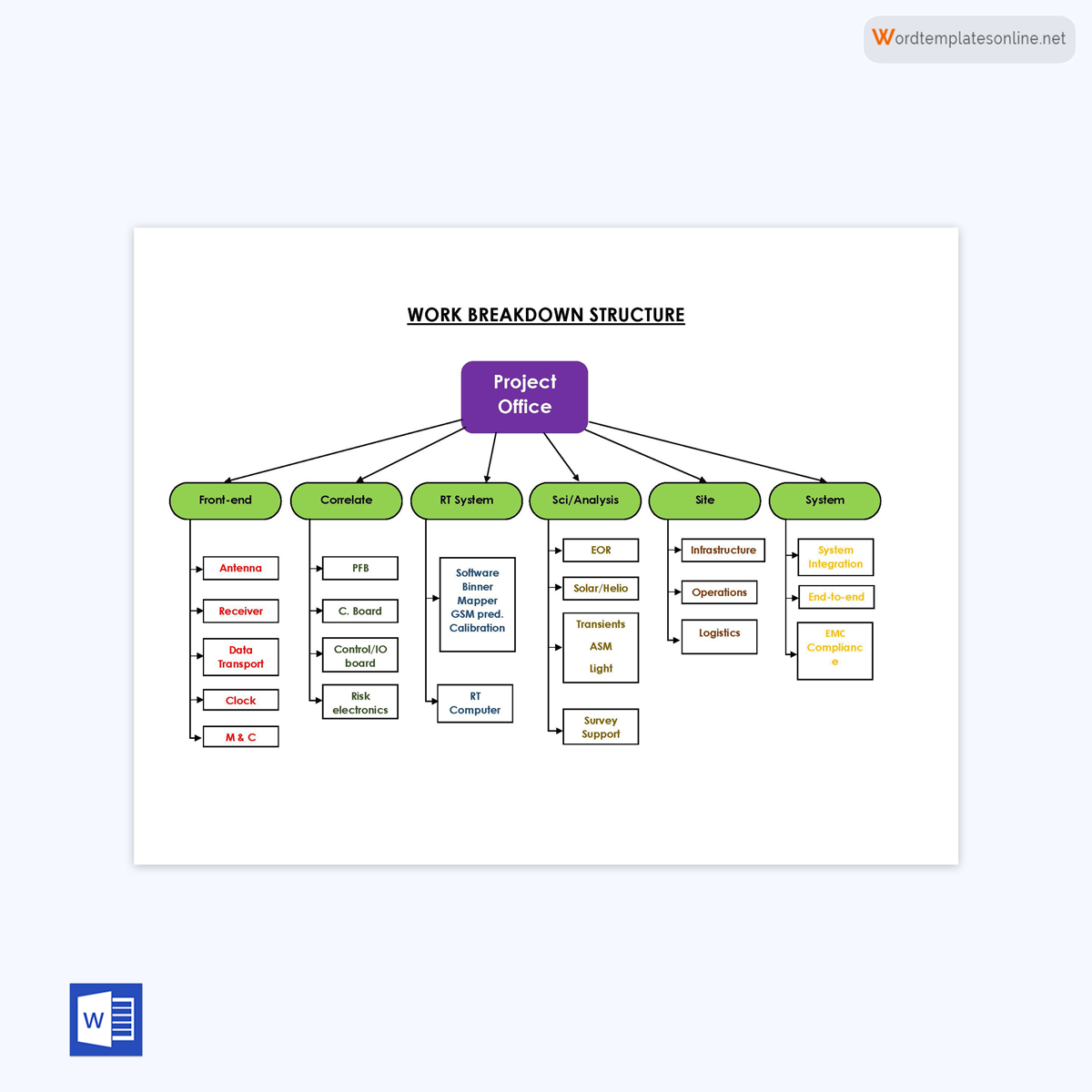
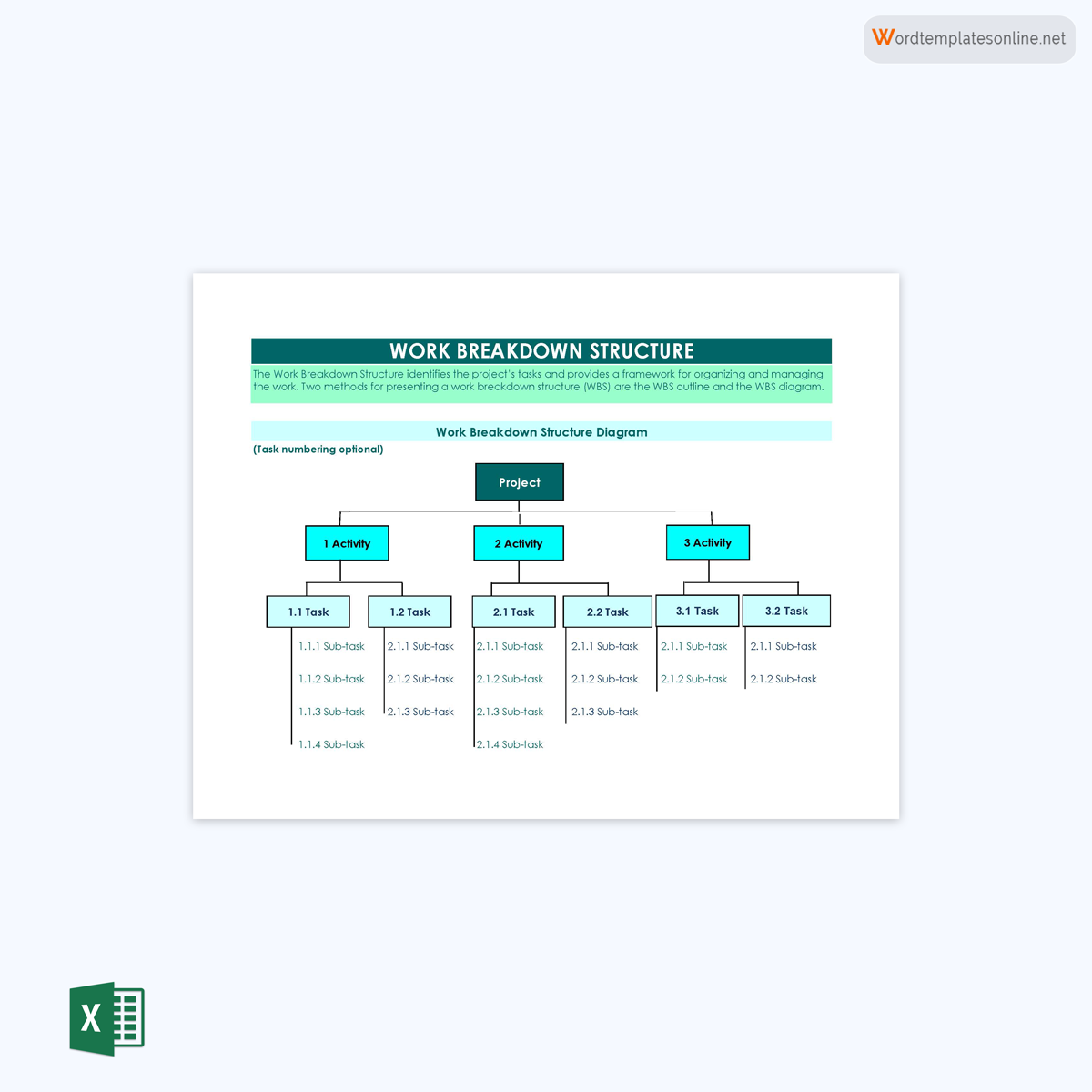
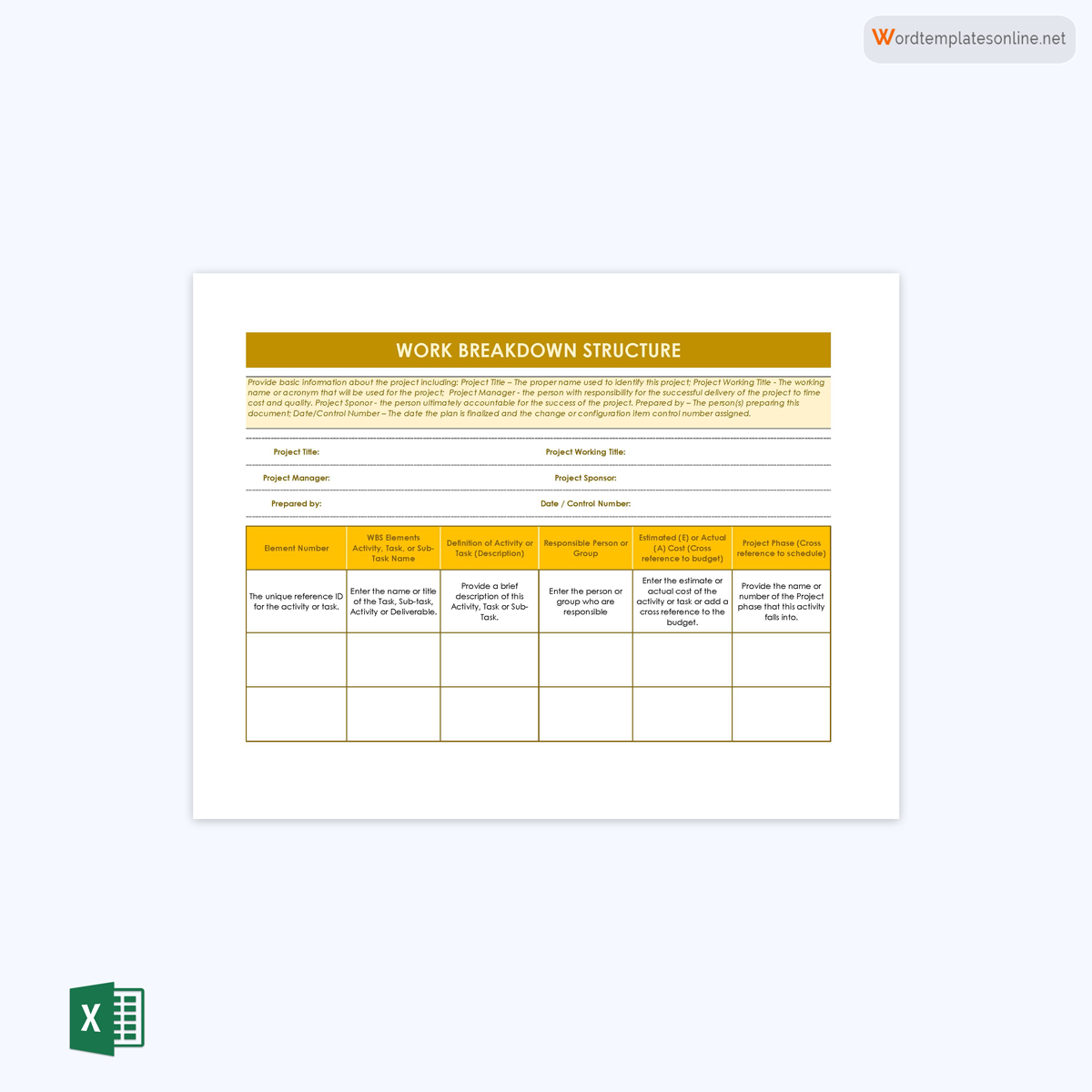
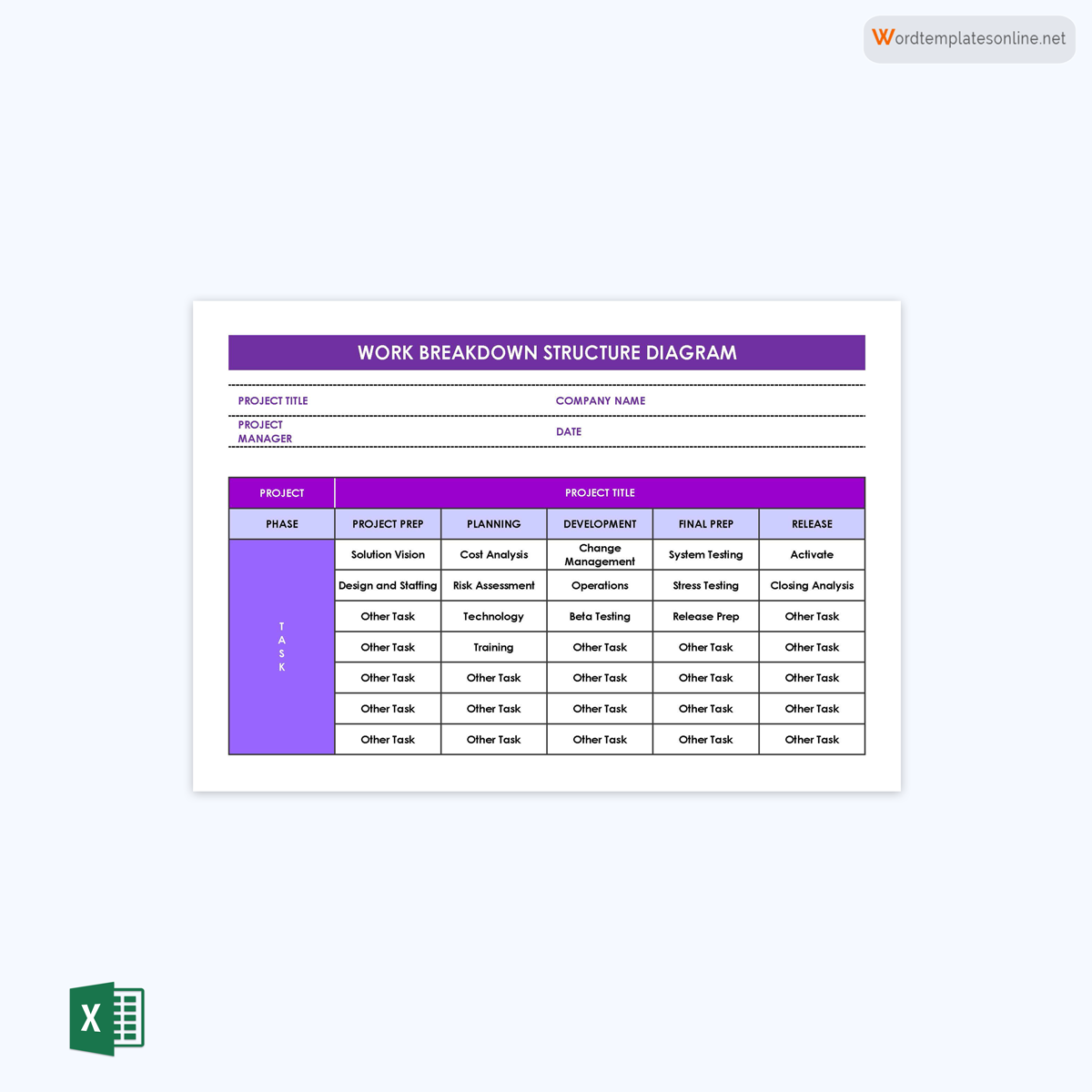
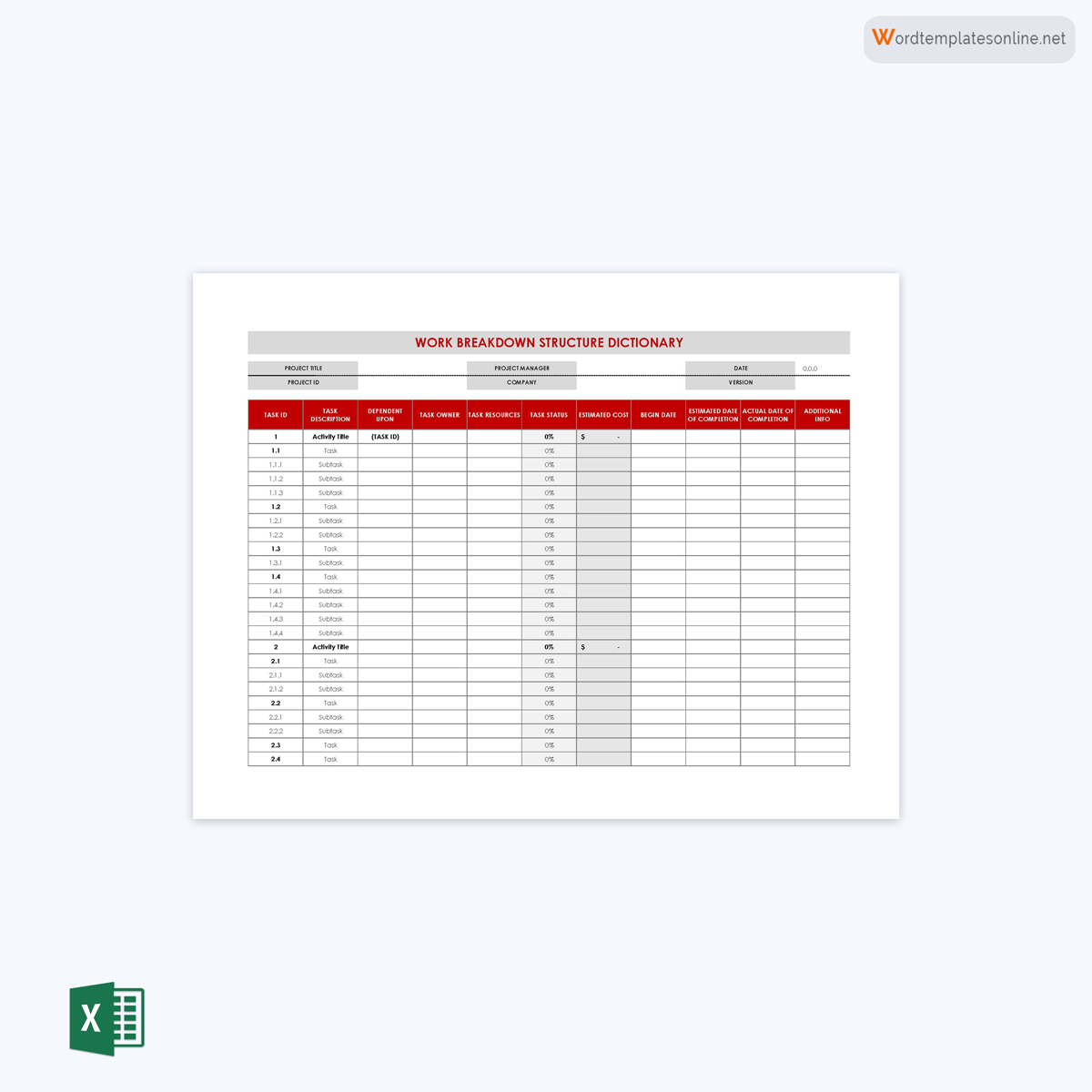
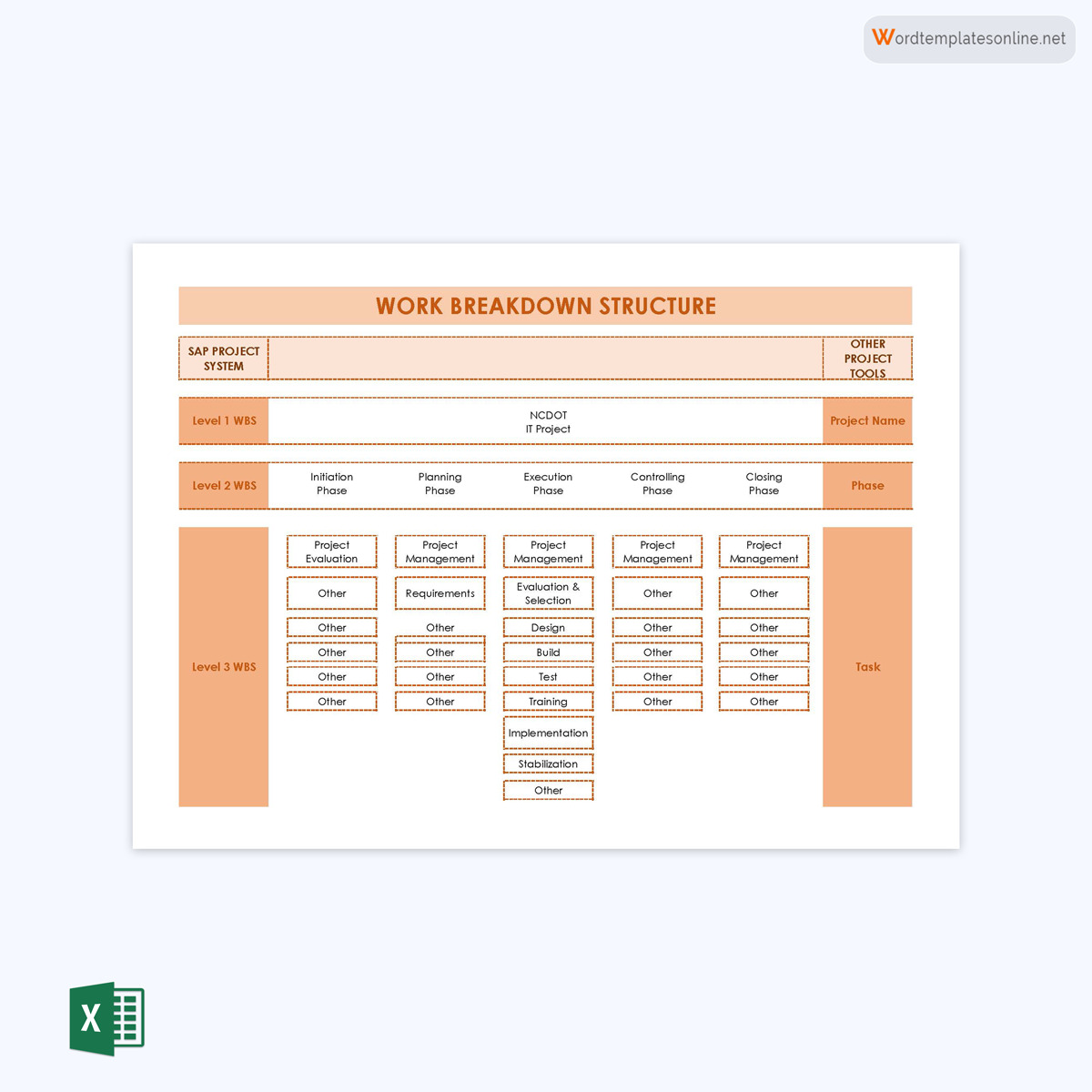
Effective Practices to Create a WBS Template
A good WBS should help a project manager in resource and risk management, project scheduling, status reports and improve the team’s efficiency overall.
The following practices can be used when preparing the WBS to ensure this is achieved:
Hierarchy
The work breakdown structure template should adopt a hierarchical structure. The template should be organized in levels where the parent level or level 1, births level 2, etc. Therefore, tasks under each level must be linked to the deliverable at level 1.
100 percent rule
Each WBS must represent 100% of the work that has to be completed by the project team and thus the overall goals and objectives. Additionally, tasks under each level must also represent 100% of the work needed to produce the associated deliverable. Therefore, child levels must equate to 100% of the work needed to complete the parent level successfully.
Mutually exclusive elements
Tasks under each level should be mutually exclusive, meaning once a task has been added, there should be no other tasks that fulfil the same responsibilities. Also, a task should not be added twice as the 100% rule has to be satisfied.
Outcome-oriented
A WBS should be outcome-oriented. This means the outcomes and deliverables should be the focus of the WBS. There must be a clear relationship between the task and the product, service, or outcome needed to produce a project deliverable. It is easier to satisfy this rule if the tasks are named using nouns and not verbs.
The 8/80 rule
Each structure should meet the 8/80 rule. This rule declares that the task’s estimated duration should not be less than 8 hours or exceed 80 hours. Tasks shorter than 8 hours should be consolidated, while tasks over 80 hours should be broken down further. Note that the 80 hours can be indicated as ten working days in some cases. An extension of this rule states that no work package or task should take longer than the reporting period. Therefore, if the reporting period is bi-weekly, the work package should not exceed the two weeks duration.
Three levels
It is also considered good practice to ensure the structure template has three levels of detail – typically overall project objectives, deliverables, and tasks. More often than not, three levels of details will be enough to capture the project scope and the necessary information adequately.
Make assignments
A good work breakdown structure should assign tasks to specific individuals or teams. A WBS with no assignments can be difficult to interpret and may lead to confusion. Assigning the teams and team members specific responsibilities ensures the right person does exemplary work.
Frequently Asked Question
A WBS has multiple benefits depending on how it is utilized in a project. However, the most notable benefits are that it helps create the project schedule, creates accountability within the team, reduces vagueness regarding what each person is expected to do, organizes the team, and can also be used to monitor and evaluate progress.
Conclusion
Both new and experienced project managers use work breakdown structure templates. While the document is ideally meant to be a simple representation of work to be done, it can become complex and confusing as it is developed. Therefore, project managers should find a way to make the WBS interpretable and straightforward for the team.
There is no standard technique for creating a work breakdown structure. However, reviewing WBS from previous projects using templates and including the components discussed in this article can simplify the process. Combining visual and written elements, a WBS becomes an essential work management tool as it becomes easy for every team member to interpret. The WBS template should be updated as the work progresses.




